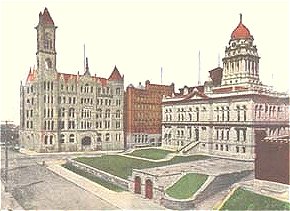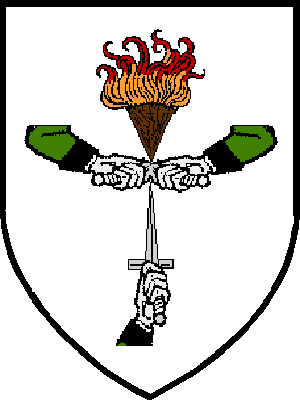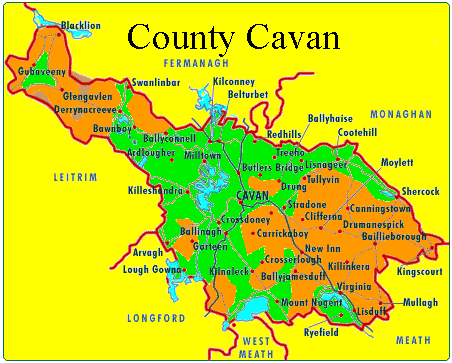Constantine Joseph "C.J." Smyth, was born in
County Cavan, Ulster, Ireland,
on December 4, 1859, the son of Bryan and Rose (Clark) Smyth.
This was a time of great turmoil in
Ireland,
and, in 1870, his parents sent him to the
United States in the care of a wealthy uncle in New York.
Constantine attended a private school in Brooklyn, probably with
the sponsorship of
his uncle and, after his uncle's death in about 1878, he
joined the westward tide of
immigrants following the new railroads across America.
The Omaha newspaper later wrote of him at this time as being
"friendless and penniless."
He stopped first in Chicago, but after only a few weeks,
he became so dissatisfied by the big city that he hitched a ride on a
freight car, destination: the frontier town of
Omaha, Nebraska.

Omaha, Nebraska
A determined young man, he folded papers for the
old Omaha Herald, sleeping under
his counter at the Herald office, and going to school at
Creighton University
during the day. In the words of his family, he was
"smart, charming and ambitious,"
and by 1882, he had graduated from Creighton with a
Master of Arts degree. He decided he
wanted to be a lawyer and studied law at night, under
the tutelage of John D. Howe and
Herbert J. Davenport, while working days in the
office of the freight auditor for the
Union Pacific Railroad Company.

By 1885, he was well enough versed in the law to be
admitted to the Nebraska Bar and
begin a practice in Omaha. By 1888, he became a member
of the law firm of Mahoney,
Minnahan & Smyth, a firm that, with the withdrawal
of Mr. Minnahan in 1892, became
the aptly named firm of Mahoney & Smyth.

Omaha Courthouse
Constantine remained an ambitious man, though, and
clearly a popular one as well,
for in 1896, he was elected Attorney General of
Nebraska, an office he held until 1900.
As Attorney General, he quickly became known as an
opponent of special interests.
While it's hard to say what impact working for the
Union Pacific had had on the young man,
he soon developed a national reputation as a foe of
big business. He actively pursued and
won a number of cases that had an important bearing
far beyond his adopted state.
As his grandson reports, "the press thoroughly
enjoyed his trust busting activities
for most of a decade and made heroes out of trust
busters like Lawyer Smyth. He became
well known to Presidents, other Attorneys General,
and other influential people
in Washington...."
During this time, Smyth, ever the idealist, prosecuted
both the Nebraska State Treasurer
and the State Auditor, risky undertakings for
any politician, let alone a relative
political novice. The Treasurer, J. S. Bartley,
was sentenced to twenty years
in prison for embezzlement. The State Auditor,
Eugene Moore, was at first
exonerated by the Supreme Court, which found, in a most
convoluted decision, that
"the fees were not embezzled inasmuch as Moore
simply had no right to receive them...."
The money was later paid to the state by the insurance
companies involved, and on this ground,
Moore escaped the charges against him.
In one of his most famous cases, Smyth obtained a
rehearing and a modification of the decree
in the celebrated NEBRASKA MINIMUM FREIGHT RATE CASE,
which had originally gone against
the state before he took office. This victory restored
the state's right to regulate freight
rates, which had been almost taken away altogether in
the earlier decision.
Never one to shy away from a fight, he then took on two
of the largest companies in America.
The strong case he brought against
 American Telephone & Telegraph Company resulted in
the separation of AT&T from the equally monolithic Western
Union Telegraph Company,
a decision with implications in telecommunications to this day.
He also, as a result of his
aggressive prosecution of California land fraud cases,
helped the government recover land
and timber estimated at between $30,000,000 and $50,000,000
–- a significant amount of money,
particularly at the turn of the century.
American Telephone & Telegraph Company resulted in
the separation of AT&T from the equally monolithic Western
Union Telegraph Company,
a decision with implications in telecommunications to this day.
He also, as a result of his
aggressive prosecution of California land fraud cases,
helped the government recover land
and timber estimated at between $30,000,000 and $50,000,000
–- a significant amount of money,
particularly at the turn of the century.
He won many cases in the high courts under the
Sherman act and the Clayton act, including
one memorable "trust-busting" case against the
United Shoe Machinery Company. Then,
seeking greener pastures, he retired as Attorney General
and formed a partnership with
Edward P. Smith, under the name of Smyth & Smith.
Now, the Irish immigrant had his own
name first on the letterhead.
As he had done in public service, Smyth continued in
his private practice, where he won a
number of important cases. On behalf of his
successor in the Office of Attorney General,
he intervened in a state case that threatened to
take away inheritance money intended for
the Working Girls' Home in Omaha, and by
court decree, he managed to obtain the full
amount of Count Creighton's bequest to the home.
Smyth continued to be involved in politics for the
rest of his life, but he also answered
the calling of a different world – one that also
satisfied his strong belief in public service –
the world of academia. Not surprisingly, he was
immensely popular and successful here as well.
From 1905 to 1910, he was Associate Dean and Professor of
Law at the College of Law at Creighton
University.
In 1913, he was drawn back into the world of government
and politics when he was chosen as a
Special Assistant to the Attorney General of the
United States, a position followed in 1917 by
his elevation to the position of Chief Justice of
the Circuit Court of Appeals of the District
of Columbia, only the third person ever to hold the position.
Here, he used his charisma and thorough knowledge of
the law to preside over the most senior court
of appeals in the nation, and win the respect and
admiration of both his many colleagues and friends,
and his legal opponents.
He remained a man of strong convictions however, who
firmly believed in the rule of law, and he earned
the nickname of "The Dissenter" for his willingness
to publicly disagree when he thought he was right.
In fact, he filed more dissenting opinions than any
other judge on the local appellate bench at the time.
(However, it should be noted that a number of these
dissenting views were later upheld by the
U.S. Supreme Court, and some of his opinions
are still used as examples of judiciary excellence
by law schools around the country.)
As the Georgetown Law Journal noted, "In the
exposition of legal principles, his manner was
severely logical...though a scholar, his judicial
style is exceedingly simple, direct and rarely ornate..."
He held a number of other positions over the course
of his long and active life. He was a member of the
Nebraska Legislature in 1887, where he was
reinforced his image as an opponent of special privilege.
From 1889 to 1894, he was a member of the Omaha Board
of Education. He was Chairman of the
Democratic State Central Committee from 1894
to 1896; Chairman of the Nebraska Delegation to the
Democratic National Conventions of 1896 and 1904,
a Delegate to the national conventions of 1900
and 1908, and the Democratic Nominee for Governor
in 1898 and 1902. He was elected President of
the Nebraska Bar Association in 1916. Creighton
University conferred upon him an honorary Doctorate
of Law in 1918,
calling him "Creighton's best known alumnus..."
He acted as permanent chairman of the
Democratic State Convention at Grand Island, when many
Democrats took issue with Presidential Democratic Nominee
William Jennings Bryan,
and, ever a man firm in his convictions, he stood
with Bryan through the free silver campaigns,
with the result that one of his law firms was
disrupted and dissolved.
From 1920 to 1924, he served as professor at the well respected
College of Law at Georgetown University,
in Washington, D.C.
He was a Catholic who was very active in parish
work in Omaha, a member of the Knights of Columbus,
and was received in audience by the Pope in 1923.
He was married on January 7, 1889, to Katherine F.
Murphy, the daughter of Thomas Murphy of Omaha.
They had five children: Rose, wife of Clarence
Sibbernsen; Catherine, wife of Charles Burgess,
both of Omaha; Bernard of Washington, D.C.;
Edward, and Constantine Joseph Smyth, Jr., both of
New York City.
He died of cancer on April 14, 1924 in Rochester,
Minnesota, where he had gone for treatment, and he was
buried back in Omaha. More than a thousand people
attended his funeral services on Holy Thursday.
He was eulogized
as "a great man, an able lawyer...
and a gentleman of the old school."
[
EDITOR'S NOTE: I'm still researching the Smyth line in Ireland.
More information to follow as it becomes available.
Certainly, if you have information
connecting Constantine J. Smyth to your family,
please let me know! Thanks. -- RSM
]


HOME
|
Writing Resource Page
|
Genealogy Page
|
INDEX
Scott Michaud is
MAZHUDE@HOTMAIL.COM
Professional writer, editor,
fact-finder, and occasional user
of Standard American English.

Sláinte, my friend! You are one of
 people to have stopped by.
people to have stopped by.
Please let me know how you enjoyed your stay.








 American Telephone & Telegraph Company resulted in
the separation of AT&T from the equally monolithic Western
Union Telegraph Company,
a decision with implications in telecommunications to this day.
He also, as a result of his
aggressive prosecution of California land fraud cases,
helped the government recover land
and timber estimated at between $30,000,000 and $50,000,000
–- a significant amount of money,
particularly at the turn of the century.
American Telephone & Telegraph Company resulted in
the separation of AT&T from the equally monolithic Western
Union Telegraph Company,
a decision with implications in telecommunications to this day.
He also, as a result of his
aggressive prosecution of California land fraud cases,
helped the government recover land
and timber estimated at between $30,000,000 and $50,000,000
–- a significant amount of money,
particularly at the turn of the century.




